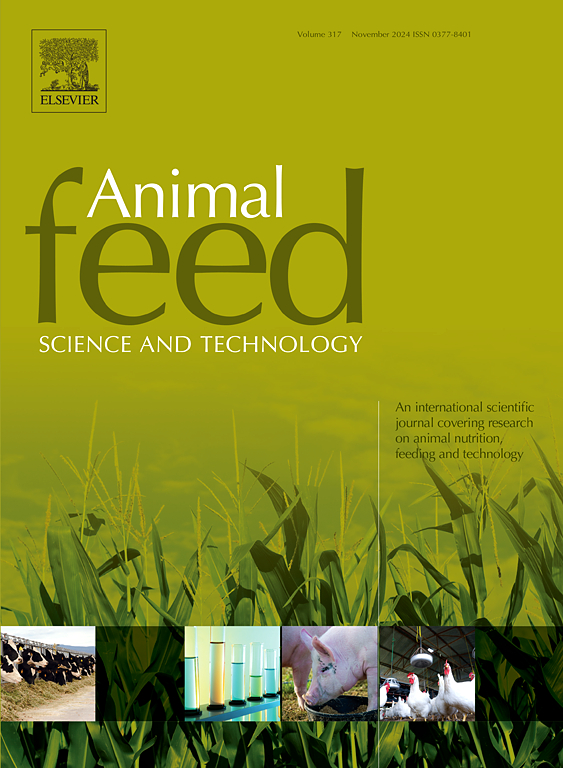优化泌乳奶牛粪便产量估算:标记选择、日粮和方法学因素的影响
IF 2.5
2区 农林科学
Q1 AGRICULTURE, DAIRY & ANIMAL SCIENCE
引用次数: 0
摘要
使用不同的外部标记物(Cr₂O₃和TiO₂)和内部标记物[不可消化干物质(iDM)、中性洗涤纤维(iNDF)和酸性洗涤纤维(iADF)]来评估粪便输出估计的准确性、精密度和稳健性。八个多产的荷斯坦奶牛(144 ± 39昏暗,34.3 ±5.10 公斤/ d牛奶产量,和592年 ± 57 公斤BW)与瘤胃套管用于复制4 × 23 d期4拉丁方设计。饲粮采用2 × 2因子配置:全原料大豆包膜(WRS);0和140 g/kg DM)和壳聚糖添加量(CHI;0和4 g/kg DM)。在24、48或72 h期间收集全部粪便。每天在瘤胃中添加外部标记物(15 g/d)。在孔隙度为12和25 µm的聚酯袋、孔隙度为25 µm的F57袋和非均匀孔隙度的无纺布袋中,培养288 h后测定内部标记物的含量。Cr2O3提供了准确和精确的估计;但随着饲粮中醚提取物的增加,其回收率有所提高。无论采样周期长短,TiO2都表现为不完全回收,导致准确度和精密度较低。内标记物回收率取决于壳聚糖包合物和袋型。在没有壳聚糖的情况下,聚酯袋(12或25 µm)中的iNDF实现了完全回收,产生了最准确、精确和可靠的估计。缺乏准确性和精密度的TiO 2和一些内部标记物(iDM和iADF)影响表观全道消化率的估计。本文章由计算机程序翻译,如有差异,请以英文原文为准。
Optimizing fecal output estimation in lactating cows: Effects of marker selection, diet, and methodological factors
A study was conducted to evaluate the accuracy, precision, and robustness of fecal output estimates using different external markers (Cr₂O₃ and TiO₂) and internal markers [indigestible dry matter (iDM), neutral detergent fiber (iNDF), and acid detergent fiber (iADF)]. Eight multiparous Holstein cows (144 ± 39 DIM, 34.3 ± 5.10 kg/d milk yield, and 592 ± 57 kg BW) with ruminal cannulas were used in a replicated 4 × 4 Latin square design with 23-d periods. The diets followed a 2 × 2 factorial arrangement: whole raw soybean inclusion (WRS; 0 and 140 g/kg diet DM) and chitosan supplementation (CHI; 0 and 4 g/kg DM). Total fecal collection was performed during 24, 48, or 72 h. External markers were administered daily (15 g/d) in the rumen. Internal marker content was determined after 288-h of incubation in polyester bags with 12 and 25 µm porosity, F57 bags with 25 µm porosity, and non-woven fabric bags with heterogeneous porosity. Cr2O3 provided accurate and precise estimates; however, its recovery increased with increasing dietary ether extract. TiO2 exhibited incomplete recovery, regardless of the length of sampling period, resulting in low accuracy and precision. Internal marker recovery depended on the chitosan inclusion and bag type. Without chitosan, iNDF in polyester bags (12 or 25 µm) achieved complete recovery, producing the most accurate, precise, and robust estimates. The lack of accuracy and precision of TiO₂ and some internal markers (iDM and iADF) affect apparent total-tract digestibility estimates.
求助全文
通过发布文献求助,成功后即可免费获取论文全文。
去求助
来源期刊

Animal Feed Science and Technology
农林科学-奶制品与动物科学
CiteScore
6.00
自引率
6.20%
发文量
266
审稿时长
3 months
期刊介绍:
Animal Feed Science and Technology is a unique journal publishing scientific papers of international interest focusing on animal feeds and their feeding.
Papers describing research on feed for ruminants and non-ruminants, including poultry, horses, companion animals and aquatic animals, are welcome.
The journal covers the following areas:
Nutritive value of feeds (e.g., assessment, improvement)
Methods of conserving and processing feeds that affect their nutritional value
Agronomic and climatic factors influencing the nutritive value of feeds
Utilization of feeds and the improvement of such
Metabolic, production, reproduction and health responses, as well as potential environmental impacts, of diet inputs and feed technologies (e.g., feeds, feed additives, feed components, mycotoxins)
Mathematical models relating directly to animal-feed interactions
Analytical and experimental methods for feed evaluation
Environmental impacts of feed technologies in animal production.
 求助内容:
求助内容: 应助结果提醒方式:
应助结果提醒方式:


